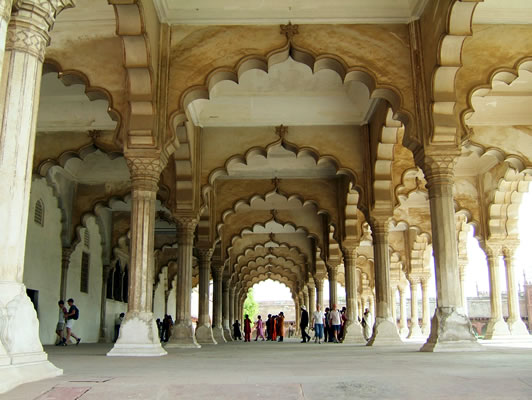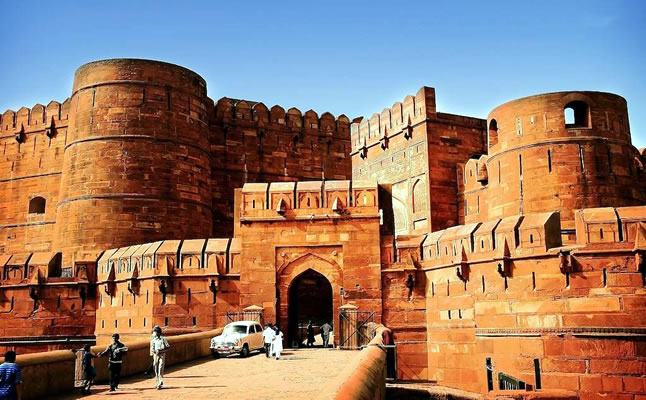|
[Not a valid template]This is the King’s own palace, splendidly set in the Haram complex, consisting of open terraces; curtains; tanks; fountains and a water-fall, a beautiful indoor garden; and living apartments, dalans and courts – all around it. It was built by Shahjehan in place of Akbar’s redstone palace. His Historian Lahauri was called it ‘Aramgah’ (The King’s Bed-Chamber). It is laid out in three receding levels, viz. the main palace overlooking the river; spacious open terraces; and the garden respectively, enabling it to stand majestically in a charmful setting, which was a specialization of Shahjehanian Architect. The main palace consists of a central hall, with Shah-Nashin (Alcoves) and rooms on the sides, and a large dalan on its front, facing the garden. It is entirely built of white marble which was gorgeously painted and gilded niches above the dados contained portraits. Dalan is made up of cusped
arches which are supported on square piers. A beautiful tank with scalloped border is there in its front. Its fountains were feb by overhead tanks. Water rippled through a shallow canal to a water-fall, behind which, true to the style, a Chini-Khanah (series of candle-niches) is provided. These water devices created an enchanting atmosphere in the palace. On either side of the main palace is an oblong pavilion with ‘Bangladar curved chhajja and roof’. Lahauri mentioned them as ‘Bungla’.
He noted that northern one was used by Shahjehan for Jharokha-Darshan (in addition to the Shah-Burj). These pavilions are built of redstone, and are fully white stuccoed and polished like white marble. The northern bungla has brackets-and lintel openings, while
the southern one has cusped arches. The former is Pre-Shahjehanian and, most probably, it is a pelic of the original palace of Akbar which was otherwise rebuilt with white marble by Shahjehan. These pavilions are fancifully, though wrongly called ‘Jahanara’ and ‘Roshanara’. An unusual feature, which is not there even in Shahjehan’s palaces of Red Fort, Delhi, is the white marble curtain (Saraparda) used for separating the main palace from these bunglas. These are divided into vertical sections, each one bearing a trefoil arch. Otherwise these are quite plain, at present Anguri Bagh is a beautiful indoor garden, charmfully laid out in front of the main palace. It is divided into four quarters (Char-bagh) by white marble raised causeways. Each quarter having geometrically drawn parterres. On its three other sides are double-storeyed living apartments which are of redstone, all exteriorly white-stuccoed. Securely set between the Bengali-Mahal and Machchhi-Bhawan, closed and in purdah stillfully open and airy with a spacious garden. This palace was an ideal medieval Harem complex.
|




